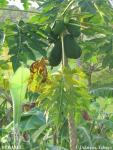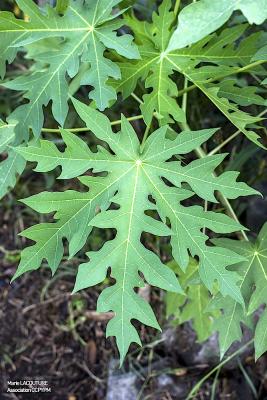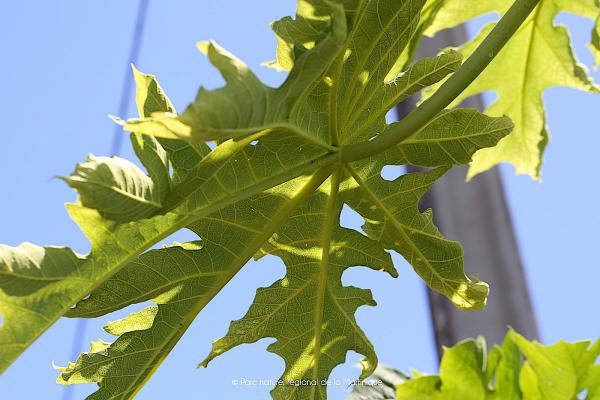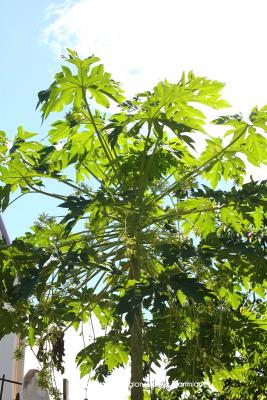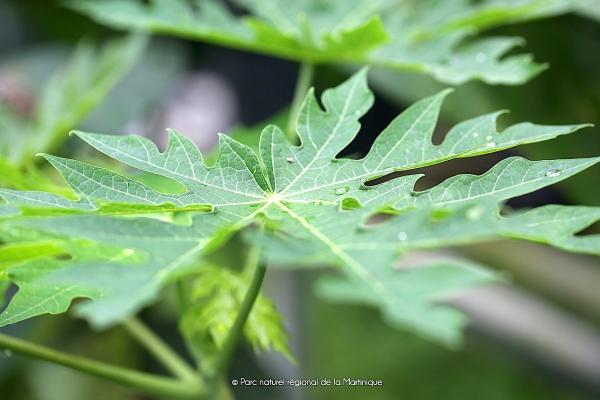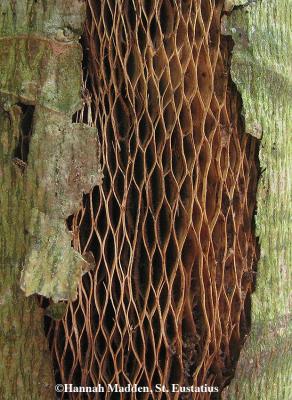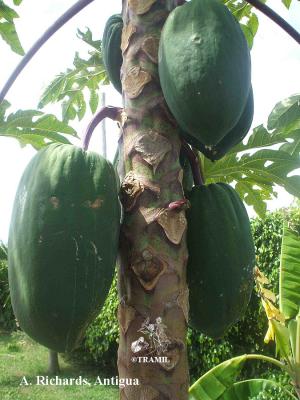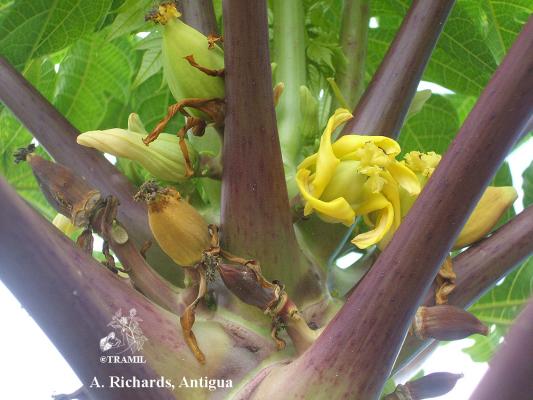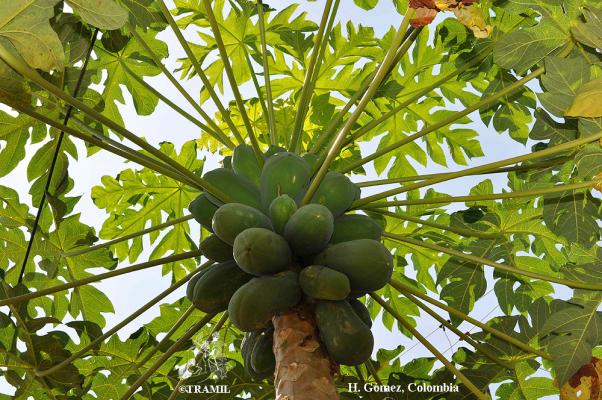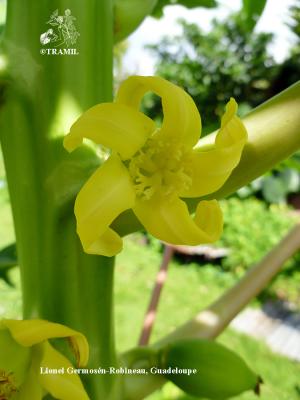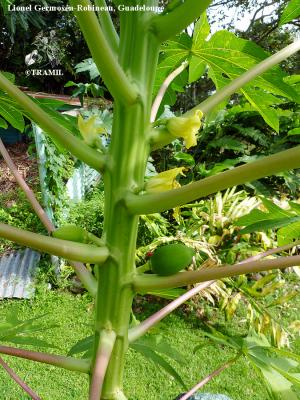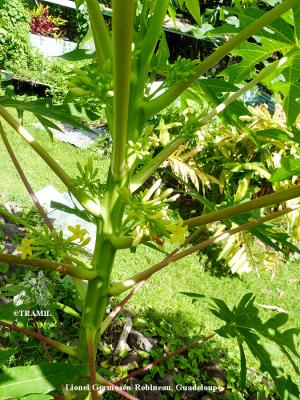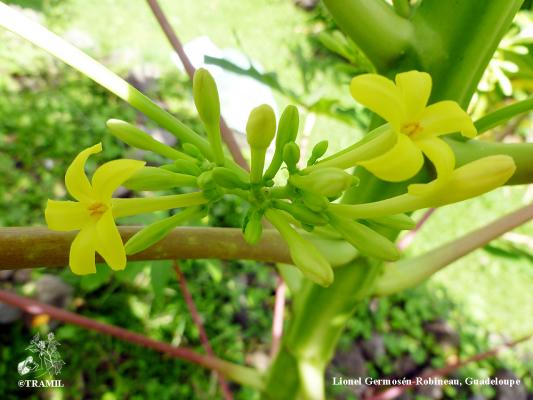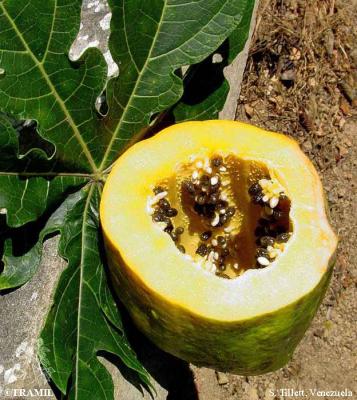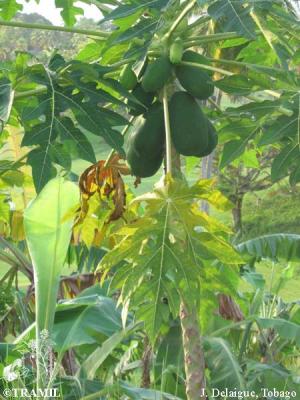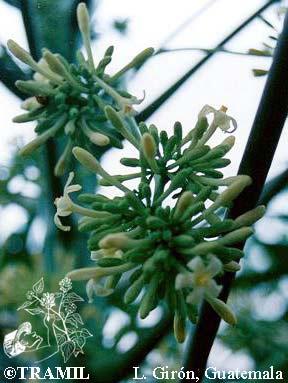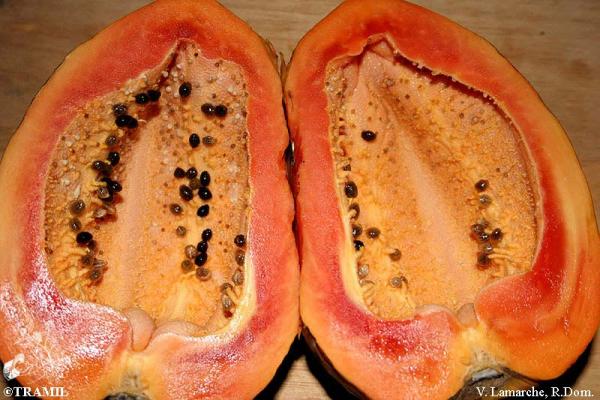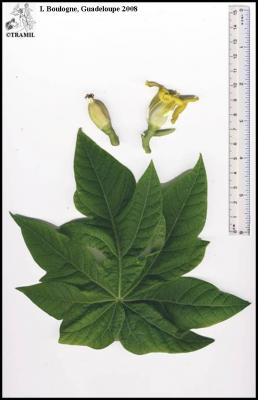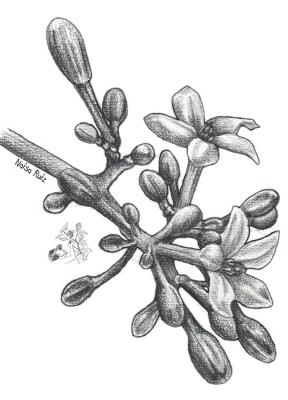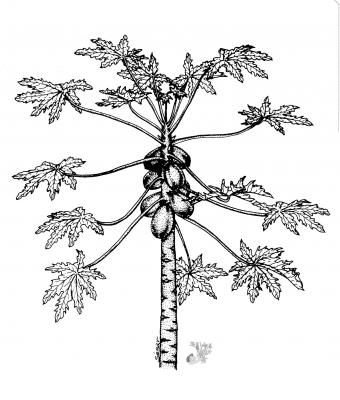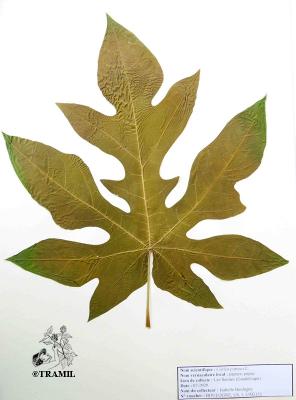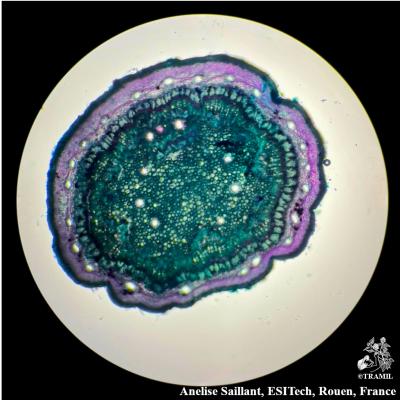Noms vernaculaires
(dans les territoires avec usage significatif TRAMIL)
Haïti:
- papay
Dominique:
- pawpaw
Distribution géographique
Originaire d'Amérique tropicale, très cultivée sous les tropiques.
Description botanique
Petit arbre à tige unique rarement ramifiée, terminée par un bouquet de grandes feuilles de 20 à 60 cm, habituellement digitées. Fleurs mâles garnies d'étamines formant des panicules de 10 cm ou davantage, fleurs femelles à corolle jaune avec pétales en spirale. Fruit sphérique ou formant un globe légèrement allongé dont le diamètre peut atteindre 30 cm, jaune ou orangé, avec un suc laiteux; nombreuses graines noires.
Voucher(s)
Girón, 227, CFEH
Pharmacopée
Ed.3References
1 CHARLES C, 1988
TRAMIL survey. Movement for Cultural Awareness MCA, Roseau, Dominica.
2 WENIGER B, ROUZIER M, 1986
Enquête TRAMIL. Service Oecuménique d'Entraide SOE, Port au Prince, Haïti.
3 MAC LEOD AJ, PIERIS NM, 1983
Volatile components of papaya (Carica papaya L.) with particular reference to glucosinolate products. J Agric Food Chem 31(5):1005-1008.
4 JINDAL KK, SINGH RN, 1975
Phenolic content in male and female Carica papaya: Possible physiological marker for sex identification of vegetative seedlings. Physiol Plant 33(1):104-107.
5 TANG CS, 1971
Benzyl isothiocyanate of papaya fruit. Phytochemistry 10:117-121.
6 RIVERA DM, YAHIA EM, GONZALEZ GA, 2010
Phenolic and carotenoid profiles of papaya fruit (Carica papaya L.) and their contents under low temperature storage. J Sci Food Agric 90(14):2358-2365.
7 GAYOSSO L, YAHIA E, GONZALEZ G, 2011
Identification and quantification of phenols, carotenoids, and vitamin C from papaya (Carica papaya L., cv. Maradol) fruit determined by HPLC-DAD-MS/MS-ESI. Food Research International 44:1284-1291.
8 HASHEM FM, HAGGAG MY, GALAL AMS, 1980
A phytochemical study of Carica papaya L. growing in Egypt. Egypt J Pharm Sci 21(3/4):199-214.
9 SELVARAJ Y, PAL DK, 1982
Changes in the chemical composition of papaya (Thailand variety) during growth and development. J Food Sci Technol 19:257-259.
10 PICKERSGILL RW, SUMNER IG, GOODENOUGH PW, 1990
Preliminary crystallographic data for protease omega. Eur J Biochem 190(2):443-444.
11 GIMLETTED JD, 1939
A dictionary of Malayan medicine. New York, USA: Oxford University Press.
12 ARGUETA A, CANO L, RODARTE ME, 1994
Atlas de las plantas de la medicina tradicional mexicana. Tomo II. México D.F., México: Instituto Nacional Indigenista. pp1117-1119.
13 IDSTEINS H, BAUER C, SCHREIER P, 1985
Volatile acids in tropical fruits: cherimoya (Annona cherimolia Mills.), guava (Psidium guajava L.), mango (Mangifera indica L. var. alphonso), papaya (Carica papaya L.). Z Lebensm Unters Forsch 180(5):394-397.
14 PINO J, ALMORA K, MARBOT R, 2003
Volatile components of papaya (Carica papaya L., Maradol variety) fruit. Flavour & Fragrance J 18(6):492-496.
15 KERHARO J, ADAM J, 1974
La Pharmacopée sénégalaise traditionnelle. Paris, France: Ed. Vigot Frères.
16 DUKE JA, 1992
Handbook of phytochemical constituents of GRAS herbs and other economic plants. Boca Raton, USA: CRC Press.
17 HEGNAUER R, 1973
Chemotaxonomie der Pflanzen. Basel, Schweiz: Birkhauser Verlag. 6:882.
18 TANG C, 1979
New macrocyclic piperideine alkaloids from papaya leaves: dehydrocarpaine I and II. Phytochemistry 18(4):651-652.
19 DUKE JA, ATCHLEY AA, 1986
Handbook of proximate analysis tables of higher plants. Boca Raton, USA: CRC Press p36.
20 CACERES A, 1992
Antigonorrhoeal activity of plants used in Guatemala for the treatment of sexually transmitted diseases. Informe TRAMIL. Facultad de Farmacia, Universidad de San Carlos, Guatemala, Guatemala.
21 CACERES A, MENENDEZ H, MENDEZ E, COHOBON E, SAMAYOA BE, JAUREGUI E, PERALTA E, CARRILLO G, 1995
Antigonorrhoeal activity of plants used in Guatemala for the treatment of sexually transmitted diseases. J Ethnopharmacol 48(2):85-88.
22 EMERUWA AC, 1982
Antibacterial substances from Carica papaya fruit extract. J Nat Prod 45(2):123-127.
23 OSATO JA, SANTIAGO LA, REMO GM, CUADRA MS, MORI A, 1993
Antimicrobial and antioxidant activities of unripe papaya. Life Sci 53(17):1383-1389.
24 GEORGE M, PANDALAI KM, 1949
Investigations on plant antibiotics. Part IV. Further search for antibiotic substances in Indian medicinal plants. Indian J Med Res 37:169-181.
25 GUNDIDZA M, 1986
Screening of extracts from Zimbabwean higher plants II: antifungal properties. Fitoterapia 57(2):111-113.
26 GIORDANI R, SIEPAIO M, MOULIN-TRAFFORT J, REGLI P, 1991
Antifungal action of Carica papaya latex: isolation of fungal cell wall hydrolysing enzymes. Mycoses (Marseille) 34(11/12):469-477.
27 YASUKAWA K, YAMAGUCHI A, ARITA J, IKEDA A, TAKIDO M, 1993
Inhibitory effect of edible plant extracts on 12-O-tetradecanoylphorbol-13-acetate-induced ear oedema in mice. Phytother Res 7(2):185-189.
28 SRIPANIDKULCHAI B, WONGPANICH V, LAUPATTARAKASEM P, SUWANSAKSRI J, JIRAKULSOMCHOK D, 2001
Diuretic effects of selected Thai indigenous medicinal plants in rats. J Ethnopharmacol 75(2-3):185-190.
29 STARLEY IF, MOHAMMED P, SCHNEIDER G, BICKLER SW, 1999
The treatment of pediatric burns using topical papaya. Burns 25(7):636-639.
30 SOUZA BRITO A, 1988
Acute toxicity of the aqueous extract of Carica papaya. (Toxicidad aguda del extracto acuoso de raíz de Carica papaya). Informe TRAMIL. Dep. de Fisiología y Biofísica, Universidad de Campinas, Campinas, Brasil.
31 GarcIa-GonzAlez M, Coto MT, GonzAlez CS, Pazos L, 2001
Repeated dose dermal irritability of the grated fresh fruit of Carica papaya. (Irritabilidad dérmica del fruto fresco rallado de Carica papaya dosis repetida). Informe TRAMIL. Laboratorio de Ensayos Biológicos LEBi, Escuela de Medicina, Universidad de Costa Rica, San Pedro, Costa Rica.


